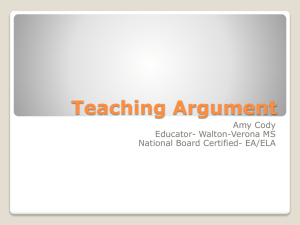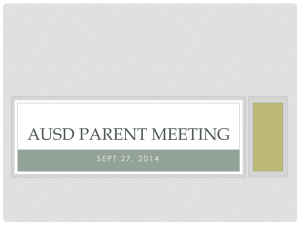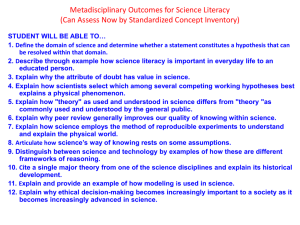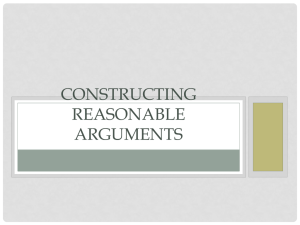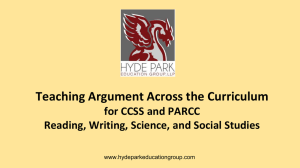Our PowerPoint presentation - Hyde Park Education Group, LLP
advertisement
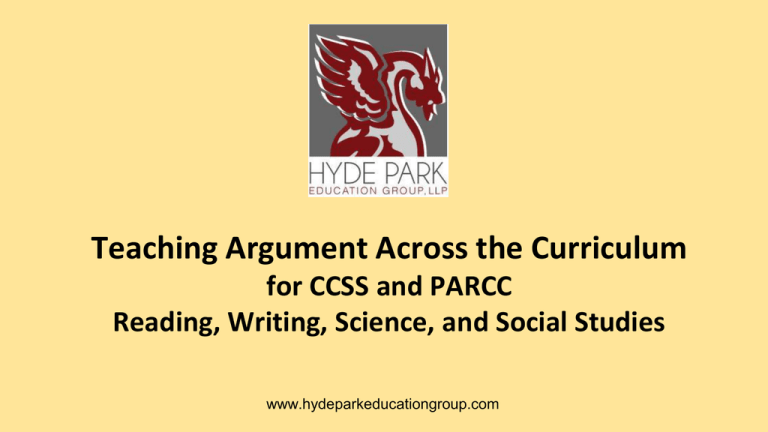
Teaching Argument Across the Curriculum for CCSS and PARCC Reading, Writing, Science, and Social Studies www.hydeparkeducationgroup.com Julianna Cucci Elizabeth (Betsy) Kahn Shirley Morikuni jlcucci@uchicago.edu ekahn@uchicago.edu saho@uchicago.edu www.hydeparkeducationgroup.com “The federal government can make states, localities and schools do things — but not necessarily do them well. Since decades of research make it clear that what matters for evaluating employees or turning around schools is how well you do it — rather than whether you do it a certain way — it’s not surprising that well-intentioned demands for “bold” federal action on school improvement have a history of misfiring. They stifle problem-solving, encourage bureaucratic blame avoidance and often do more harm than good.” Rick Hess and Linda Darling-Hammond Workshop Agenda Participants will ● examine how argument writing skills are necessary for success with CCSS and PARCC. ● develop common vocabulary for discussing the teaching of writing effective arguments. ● explore research-based best practices for teaching argument well. ● apply argument writing to a range of subject areas. ● look into lessons, formative and summative assessments for argument writing. A VOLUPTUARY under the horrors of Digestion Argument Terms Claim Evidence Reasoning Major Claim Sub-Claim Argument of Fact Argument of Definition Argument of Policy Formative Assessment Possibilities • I have been invited to dinner with the Prince Of Wales (The Voluptuary). Should I go? • Will the Prince of Wales be a good King? • What criticisms(s) does John Gillray’s etching of the Prince of Wales (A Voluptuary Under the Horrors of Digestion) level against the prospective king? Workshop Objective Participants will leave here today with ideas about how to revise or design argument-driven instruction for their own classrooms . . . and with a rationale for using engaging activities as test prep. From The Special Place of Argument in the Standards: The Standards put particular emphasis on students’ ability to write sound arguments about substantive topics and issues, as this ability is critical to college and career readiness … Taken from Common Core State Standards for English Language Arts & Literacy in History/Social Studies, Science, and Technical Subjects Appendix A: Research Supporting Key Elements of the Standards Gerald Graff (2003) writes that “argument literacy” is fundamental to being educated... K–12 schools should “teach the conflicts” so that students are adept at understanding and engaging in argument (both oral and written) when they enter college. Neil Postman (1997) calls argument the soul of an education . . . When teachers ask students to consider two or more perspectives on a topic or issue, something far beyond surface knowledge is required: students must think critically and deeply, assess the validity of their own thinking, and anticipate counterclaims in opposition to their own position. PARCC 4th Grade Research Task: Your class has been studying about the survival of ponies on Assateague Island. Using information from the articles and video, describe the roles that both the horses and humans play in horses’ survival. Use evidence from the articles and the video to support you answer. 8th Grade Research Task: Write an essay comparing the information presented in the video with that presented in the article “Elephants Can Lend a Helping Trunk” and the passage from “Elephants Know When They Need a Helping Trunk in a Cooperative Task.” Remember to use evidence from the video, the article, and the passage to support your answer. 9th Grade Research Task Write an essay that compares and contrasts a primary argument in each text that you have read regarding the decision to drop the atomic bomb. Your essay should explain how effectively you think each argument supported that claim with reasoning and/ or evidence. Be sure to use evidence from the three texts to support your ideas. 6th Grade Literary Analysis Task: You have read the passage from Boy’s Life and “Emancipation: A Life Fable.” Both texts develop the theme of freedom. Write an essay that compares and contrasts the approaches each text uses to develop the theme of freedom. 8th Grade Literary Analysis Task: In Confetti Girl and Tortilla Sun, the narrators have points of view different from those of the parents. Write an essay analyzing how these differences in points of view create tension in both stories. Remember to use details from both texts to support your ideas. Writing Strands CCSS.ELA-LITERACY.CCRA.W.1 Write arguments to support claims in an analysis of substantive topics or texts using valid reasoning and relevant and sufficient evidence. CCSS.ELA-LITERACY.CCRA.W.2 Write informative/explanatory texts to examine and convey complex ideas and information clearly and accurately through the effective selection, organization, and analysis of content. CCSS.ELA-LITERACY.CCRA.W.4 Produce clear and coherent writing in which the development, organization, and style are appropriate to task, purpose, and audience. CCSS.ELA-LITERACY.CCRA.W.7 Conduct short as well as more sustained research projects based on focused questions, demonstrating understanding of the subject under investigation. CCSS.ELA-LITERACY.CCRA.W.8 Gather relevant information from multiple print and digital sources, assess the credibility and accuracy of each source, and integrate the information while avoiding plagiarism. CCSS.ELA-LITERACY.CCRA.W.9 Draw evidence from literary or informational texts to support analysis, reflection, and research. Forming an argument by examining data vs. analyzing the form What do students need to know and be able to do? Skills of Argument Questions to Ask 1. Take an overall position. Overall, what do I think? 2. Generate claims. What can I prove? 3. Select evidence. How do I know? 4. Explain reasoning. So what? or How does the evidence prove my claim? Skills of Argument Questions to Ask 5. Imagine arguments from other sides. (counter-argument) Who would disagree and why? 6. Respond to counter-argument. Why don’t their arguments convince me? Why is my evidence or reasoning better? 7. Analyze the arguments of others in different formats, i.e., videos, images, or written text. What are the claims? Evidence? Reasoning? Pre-test ● ● ● ● ● ● Identify what skills students have. Identify what skills students need to learn. Fine tune instruction. Provide a basis for demonstrating student growth (post-test). Teacher constructed. PARCC samples (constructed response). Slip or Trip? A case of who dunnit You are a member of the investigative team ... Accident or Murder? After Margaret and her husband got into a fight, she stormed out of the house and left him at home alone. Margaret drove to her country club where a party was going on. Everyone there complimented Margaret on her dress and how well it fit her slender figure, and this made her feel better. Margaret left just before one in the morning and invited a few friends to follow her home for one more drink. She got home ten minutes before they arrived, but when her friends rang the doorbell, Margaret ran outside, saying, “Something terrible happened! Charles slipped and fell on the stairs. He was coming down for another drink—he still had the glass in his hand—and I think he’s dead. Oh my God, what should I do?” The police concluded that Charles died from a wound on the head, and confirmed the fact that he’d been drunk. What do you think happened? Accident or Murder? Directions: You are a member of the investigative team. You must determine whether this was an accident or murder. Analyze the evidence in Margaret’s story and the picture, and look for clues to how and why the incident occurred. Once you’ve gathered the evidence, make your claim. Was it an accident or a murder? Slip or Trip? Looking at the evidence for clues Evidence pointing toward ACCIDENT Evidence pointing toward MURDER Learning what questions to ask ... Claim: What do you know? Is Charles’ death murder or an accident? Evidence: Based on the picture, how do you know? Reasoning: Why is that important? What does that mean? The Write-Up... Write up a report/ argument about Charles’ death in which you have a claim, the two strongest pieces of evidence, and reasoning for each piece of evidence. You might start like this: Dear Police Commissioner: Without a doubt, Charles ___________________. The most important evidence in this case . . . As a rule ... Slip or Trip Incorporate multiple texts: VISUAL and written data Practice skills, with emphasis on reasoning (linking evidence to claims) Reinforcing Claims, Evidence, and Reasoning Formative Assessment 1. CLAIM: The police should pull over that car. EVIDENCE: It is swerving all over the road. REASONING: 2. CLAIM: That man is brave. EVIDENCE: He jumped into a pool of sharks. REASONING: . 3. CLAIM: Pablo is a good parent. EVIDENCE: He buys his son whatever he wants. REASONING: 4. CLAIM: Pablo is a bad parent. EVIDENCE: He buys his son whatever he wants. REASONING: Sticky Notes Activity From Teaching Students to Write Argument, 2011 Class-Generated Data Sticky Notes What kinds of things do you like to do in your free time? Class-Generated Data Learn to use and apply basic statistics to argument Sticky Notes Simple class generated data, which students evaluate Application to science labs Can get to more complex data Applying CCSS Argument to a NGSS Project Research and Design Test and collect data Present a persuasive argument C E R Big Question: Is the sea lamprey an invasive species that could have a major impact on the Great Lakes? Claim: The sea lamprey is a super predator. Evidence (Text and lab) Reasoning Eggs How does the evidence prove your claim? Be sure to connect each piece of evidence to a scientific principle. Lamprey Trout Mouth Lamprey Perch How they feed (eat) Gills Movement Digestive System C E R Writing Sample “The sea lamprey is a super predator because, first, it produces a lot more eggs (60,000 - 100,000) than the perch (1,000 - 15,000) causing there to be many more sea lamprey to be a predator of the trout/ perch. The scientific principle that supports this is that organisms in a food web are related through producer/ consumer, predator/ prey relationships. If there are more of a predator, it will cause there to be less of the prey.” Teacher-constructed Data Carnegie Hero -- criteria provided, students apply criteria School Mascot -- complex problem, students generate and apply criteria Reparations (scenarios and case study) -- complex problem, students generate and apply criteria Scenarios Reparations Friendship Courageous Action Hero Outcast What is Liberty? Justice? Freedom of Speech? American Dream? Discrimination? Scenarios Sample Student Discussion Missy: The way she says “So there,” doesn’t sound like she’s sorry. I don’t think that Stella is really sorry… Ginger: Yeah, but how do you make her be sorry? Bobby: You can’t make her be sorry, but she should at least sound like she means it. Teacher: OK, so you want at least for her to offer a sincere apology, even if she might in her heart not really be sincere? Scenarios Sample Student Discussion Bobby: Yeah, she has to give a sincere apology. Suzy: But I don’t think that’s enough. She bit her and hurt her. Doesn’t it say that she is still bruised and sore? Stella has to do something nice to make up for hurting her. Teacher: So you want Stella to do something more? What would that be? Case Study/Role Play Imagining arguments of others: Reparations for Native Americans Which makes the best school mascot? The Lowland Gorillas The Miners The Lemurs The Manatees The Lowland Gorillas From Teaching Students to Write Argument, 2011 Assessments: Prompts and Rubrics Formative Follow-up writing Criteria-guided revision Summative Classroom School wide District wide What do all these activities have in common? ● ● ● ● ● Authentic, engaging data Complex problem(s) Talking before writing Internalize questions as thought process Process before form/product C3 and Argument “The disciplines that make up the social studies, including the behavioral and social sciences, stress the importance of arguments, and in particular, the necessity of constructing them in ways that make use of sources and data as evidence.” (C3 Framework, 57) NextGen Science and Argument “The study of science and engineering should produce a sense of the process of argument necessary for advancing and defending a new idea or an explanation of a phenomenon and the norms for conducting such arguments. In that spirit, students should argue for the explanations they construct, defend their interpretations of the associated data, and advocate for the designs they propose” (73). Percolate How might you apply these ideas to your classroom?




